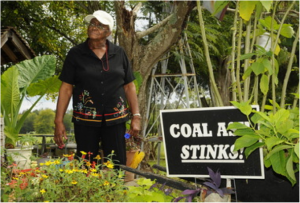
of heavy metals draining from the coal ash is unbearable to her.
Photo Credit: The Birmingham News/Joe Songer
General Overview
In December, 2014, EPA released its long-awaited coal ash rule. EPA left enforcement of the rule to the utilities (and other owners) themselves, the states, and via citizen suits. But Alabama has a troubling track record when it comes to protecting communicates from the dangers of coal ash.
In 2015, Alabama Power announced plans to close its coal ash storage ponds in response to EPA’s Coal Combustion Residuals and Effluent Limitation Guideline rules. However, the utility remains tight-lipped on the specifics of its closure plans.
Alabama is home to 9 coal-fired power plants and a total of 44 coal ash impoundments. Click the link to see how many of these impoundments are located dangerously close to Alabama’s drinking water intakes.
According to the EPA, Alabama’s impoundments have enough capacity to hold at least 28 billion gallons of coal ash. You can find each dumpsite’s capacity by clicking a power plant on the homepage and scrolling down to Power Plant Details and Maps. Annually, Alabama’s power plants generate 3.2 million tons of coal ash making the state 14th in the nation for coal ash generation.
The Environmental Integrity Project’s analysis of the EPA’s Toxics Release Inventory reveals that Alabama’s coal ash dumps contain almost 15 million pounds of toxic heavy metals making it the most toxic coal ash of any state in the country. Alabama Power’s Miller Steam Plant, located along the Locust Fork of the Black Warrior River, sent more toxic heavy metals to its impoundments than any other power plant in the United States in 2010.
In February 2013 several environmental organizations brought legal action against the Tennessee Valley Authority alleging the utility is violating the Clean Water Act at its Colbert Plant in Tuscumbia, Alabama.
Check out this map showing these sites and potentially impacted communities.
Alabama Communities Paying the Price
Although the Kingston disaster occurred in Tennessee, the aftermath of its effects are being felt in Perry County, Alabama. The rural community just south of Uniontown is the dump site for most of the 3.5 million cubic yards of coal ash removed from Kingston, Tennessee. The ash was shipped to the unlined Arrowhead landfill which was not designed for coal ash waste. Lacking protective measures such as liners and proper engineering to safeguard the community, the dump site exposes residents to toxic trash. Community members reported that they began experiencing numerous health issues after the coal ash was shipped in. Dust from the coal ash blankets their homes, cars, and streets. Additionally, staggeringly high levels of arsenic leach from the landfill, endangering residents and wildlife.

Pollution from Gorgas helped put the Black Warrior on the list of America’s most endangered rivers in 2013.
Photo by Nelson Brooke.
Flight by SouthWings
Perry County’s residents are 90% African-American and about 45% of the community is living below the poverty line. After the County Commissioners ignored citizens’ concerns 54 residents decided to file a civil rights complaint alleging discrimination against the Alabama Department of Environmental Management (ADEM). The residents claim ADEM is violating of Title VI of the Civil Rights Act of 1964. Under Title VI, federally funded government agencies must assess whether their decisions unfairly impact minority communities.
Legislation
In 2011 Representative Greg Canfield sponsored a bill to regulate coal ash disposal in Alabama. The bill, HB 50, removed exemptions for coal ash from Alabama’s solid waste disposal laws and gave the Alabama Department of Environmental Management more authority over how the ash is disposed.
Check out more information about coal ash in Alabama and the EPA’s coal plant water pollution standards for Alabama.
Create-Your-Own Coal Ash Report
Full control to create the report of your choosing listing coal plants with ash impoundments in the Southeast.
Create your report NOW!
